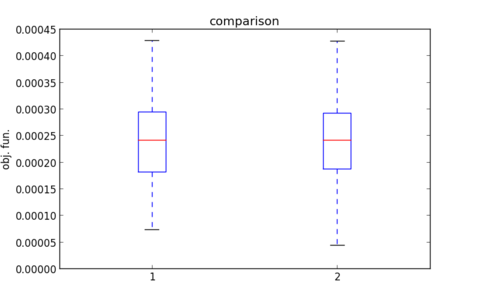Rotated and Shifted problems¶
In this tutorial we will learn how to use meta-problems. These are optimization problems that transform somehow another optimization problem. In particular we will have a look to the rotated and shifted meta-problems. Let us start creating a shifted problem.
In [1]: from PyGMO import *
In [2]: prob = problem.ackley(5)
In [3]: shifted_prob1 = problem.shifted(problem=prob)
In [4]: shifted_prob2 = problem.shifted(problem=prob,shift=15)
In [5]: shifted_prob3 = problem.shifted(problem=prob,shift=[23,-12.2,22,33,5.3])
We have used three different constructors to instantiate the new problem with a random shift vector (shifted_prob1), with a uniform shift vector (shifted_prob2) and with a fully defined shift vector (shifted_prob3). In all cases we may extract the shift vector using the corresponding attribute
In [4]: shift1 = shifted_prob1.shift_vector
Out[11]: (22.05074397709721, 42.30378775731836, 41.28781073553851, -37.032452729545746, -43.15424830101163)
We may now check that such a shift does not change the performance of a given algorithm. We choose, for this tutorial Improved Harmony Search, but you can try changing it to test others.
In [5]: l = list()
In [6]: algo = algorithm.ihs(1000);
In [7]: for i in range(100):
pop = population(prob,20)
for i in range(15):
pop = algo.evolve(pop)
l.append(pop.champion.f[0])
In [8]: l_shift = list()
In [9]: for i in range(100):
pop = population(shifted_prob1,20)
for i in range(15):
pop = algo.evolve(pop)
l_shift.append(pop.champion.f[0])
In [10]: boxplot([l,l_shift])
which will produce a plot similar to:

where one can clearly see how the algorithm ihs does not change its performances when the search space is shifted.
We now repeat the same procedure for a rotated problem.
In [1]: from PyGMO import *
In [2]: prob = problem.ackley(5)
In [3]: shifted_prob = problem.rotated(problem=prob)
Also in the case of the rotated problem the kwarg rotation allows to pass a rotation matrix directly, otherwise a random orthonormal matrix will be generated and can be extracted by the problem.rotation attribute.
Running the same procedure as for the shifted problem returns a picture like the one below.

Which clearly indicates how the rotation affects negatively the algorithm performance.
Note that meta-problems can be nested together, so it is perfectly valid to have
In [1]: from PyGMO import *
In [2]: prob = problem.ackley(5)
In [3]: new_prob = problem.rotated(problem.shifted(problem.rotated(prob)))
To make sure one can reconstruct the original problem, the transformations applied are logged in the problem __repr__ method
In [4]: print new_prob
Out[4]:
Problem name: Ackley [Rotated] [Shifted] [Rotated]
Global dimension: 5
Integer dimension: 0
Fitness dimension: 1
Constraints dimension: 0
Inequality constraints dimension: 0
Lower bounds: [-1.4142135623730951, -1.4142135623730951, -1.4142135623730951, -1.4142135623730951, -1.4142135623730951]
Upper bounds: [1.4142135623730951, 1.4142135623730951, 1.4142135623730951, 1.4142135623730951, 1.4142135623730951]
Constraints tolerance: 0
Rotation matrix:
-0.599649 0.20824 0.0152832 -0.740073 -0.221622
-0.263871 -0.341942 0.873749 0.072256 0.211634
-0.114375 -0.709787 -0.157299 0.0906273 -0.670943
0.663241 0.209505 0.425168 -0.326385 -0.478461
0.343255 -0.540391 -0.17555 -0.576482 0.476451
Shift vector: [-2.5281990225671565, 2.2507667730831695, 2.260031719866459, -2.6037537655145679, -0.45739118339223306]
Rotation matrix:
-0.469888 -0.334498 -0.813054 0.0761044 -0.0216481
-0.416312 -0.467594 0.372853 -0.513315 0.453352
0.413702 0.0719025 -0.277365 0.149243 0.851161
0.182474 0.391322 -0.341818 -0.830096 -0.0875853
-0.633596 0.714957 0.0784432 0.139221 0.24871